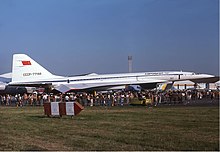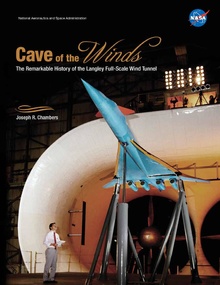Supersonic transport
SST designs flying at least three times as fast as existing subsonic transports were possible, and would thus be able to replace as many as three planes in service, and thereby lower costs in terms of manpower and maintenance.
In Britain and France, government-subsidized SST programs quickly settled on the delta wing in most studies, including the Sud Aviation Super-Caravelle and Bristol Type 223, although Armstrong-Whitworth proposed a more radical design, the Mach 1.2 M-Wing.
[2] By the early 1960s, the designs had progressed to the point where the go-ahead for production was given, but costs were so high that the Bristol Aeroplane Company and Sud Aviation eventually merged their efforts in 1962 to produce Concorde.
Both problems impacted the thinking of lawmakers, and eventually Congress dropped funding for the US SST program in March 1971,[4][5][6][7][8] and all overland commercial supersonic flight was banned over the US.
[9] Presidential advisor Russell Train warned that a fleet of 500 SSTs flying at 65,000 ft (20 km) for a period of years could raise stratospheric water content by as much as 50% to 100%.
After Concorde was privatized, cost reduction measures (notably the closing of the metallurgical wing testing site which had done enough temperature cycles to validate the aircraft through to 2010) and ticket price raises led to substantial profits.
[19] On 25 July 2000, Air France Flight 4590 crashed shortly after take-off with all 109 occupants and four on ground killed; the only fatal incident involving Concorde.
[21] Because an aircraft's design must provide enough lift to overcome its own weight, a reduction of its L/D ratio at supersonic speeds requires additional thrust to maintain its airspeed and altitude.
Additionally, the large frontal area taken up by the low-pressure fan at the front of the engine increases drag, especially at supersonic speeds, and means the bypass ratios are much more limited than on subsonic aircraft.
SSTs also require a much stronger (and therefore heavier) structure because their fuselage must be pressurized to a greater differential than subsonic aircraft, which do not operate at the high altitudes necessary for supersonic flight.
Higher fuel costs and lower passenger capacities due to the aerodynamic requirement for a narrow fuselage make SSTs an expensive form of commercial civil transportation compared with subsonic aircraft.
[26] Therefore, a future SST might well benefit from a variable cycle engine, where the specific thrust (and therefore jet velocity and noise) is low at take-off, but is forced high during supersonic cruise.
[27] The annoyance of a sonic boom can be avoided by waiting until the aircraft is at high altitude over water before reaching supersonic speeds; this was the technique used by Concorde.
During the original SST efforts in the 1960s, it was suggested that careful shaping of the fuselage of the aircraft could reduce the intensity of the sonic boom's shock waves that reach the ground.
When it comes to public policy, for example, the FAA prohibits commercial airplanes from flying at supersonic speeds above sovereign land governed by the United States because of the negative impact the sonic boom brings to humans and animal populations below.
Designers of Concorde spent 5000 hours optimizing the vehicle shape in wind tunnel tests to maximize the overall performance over the entire flightplan.
[citation needed] Also, for-profit companies generally prefer low risk business plans with high probabilities of appreciable profit, but an expensive leading-edge technological research and development program is a high-risk enterprise, as it is possible that the program will fail for unforeseeable technical reasons or will meet cost overruns so great as to force the company, due to financial resource limits, to abandon the effort before it yields any marketable SST technology, causing potentially all investment to be lost.
Noise exposed area around airports could double compared to existing subsonic aircraft of the same size, with more than 300 operations per day at Dubai and London Heathrow, and over 100 in Los Angeles, Singapore, San Francisco, New York-JFK, Frankfurt, and Bangkok.
Frequent sonic booms would be heard in Canada, Germany, Iraq, Ireland, Israel, Romania, Turkey, and parts of the United States, up to 150–200 per day or one every five minutes.
[50] The SAI Quiet Supersonic Transport is a 12-passenger design from Lockheed Martin that is to cruise at Mach 1.6, and is to create a sonic boom only 1% as strong as that generated by Concorde.
[54] NASA should fly a low-boom demonstrator in 2019, reduced from double bangs to soft thumps by airframe shaping, to inquire community response, in support of a prospective FAA and ICAO ban lift in the early 2020s.
[61] In October 2018, the reauthorization of the FAA planned noise standards for supersonic transports, giving developers a regulatory certainty for their designs, mostly their engine choice.
[62] The FAA should make a proposition for landing-and-takeoff noise before March 31, 2020, for a rule after 2022; and for overland sonic boom from the end of 2020, while NASA plans to fly the Lockheed Martin X-59 QueSST low-boom flight demonstrator from 2021 for ICAO standards in 2025.
Lower airport noise and sonic boom are allowed by shaped-boom design; integrated low-noise propulsion; swept-wing supersonic natural laminar flow; and the cockpit external vision system (XVS).
Integrated low-noise propulsion include advanced plug nozzle designs, noise shielding concepts and distortion-tolerant fan blades.
[68] In August 2020, Virgin Galactic with Rolls-Royce unveiled the concept of a Mach 3 capable twinjet delta wing aircraft that can carry up to 19 passengers.
[71] In April 2024, Boom received FAA licensure for Mach 1 and beyond tests of its XB-1 to be conducted at the Black Mountain Supersonic Corridor, in Mojave, California.
[citation needed] At the June 2011 Paris Air Show, EADS unveiled its ZEHST concept, cruising at Mach 4 (4,400 km/h; 2,400 kn) at 105,000 ft (32,000 m) and attracting Japanese interest.
[75] STRATOFLY MR3 is an EU research program (German Aerospace Center, ONERA and universities) with the goal of developing a cryogenic fuel 300-passenger airliner capable to fly at about 10,000 km/h (Mach 8) above 30 km of altitude.
[82] The Boeing hypersonic airliner would be powered by a turboramjet, a turbofan that transitions to a ramjet at Mach 6 would avoid the need for a scramjet, similar to the SR-71 Blackbird's Pratt & Whitney J58, but shutting off the turbine at higher speeds.










